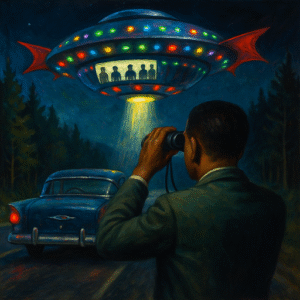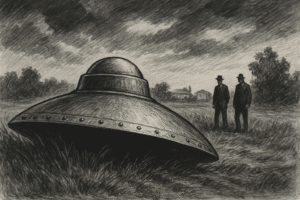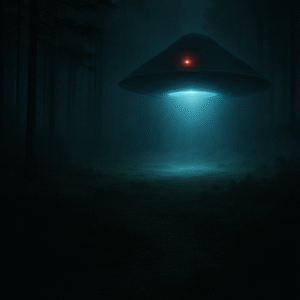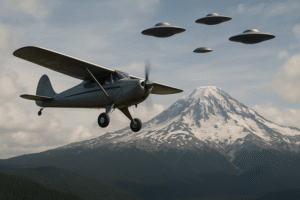Who they were
Barney and Betty Hill lived in Portsmouth, New Hampshire. He worked nights for the U.S. Postal Service and was a WWII veteran; she was a social worker and UNH alum. Both were active in their Unitarian church and the NAACP. They were an interracial couple — Barney was Black, Betty was white — which was uncommon in early-1960s America, and they were locally visible as civil-rights-minded community members. Ages in September 1961: Betty 42 (b. 1919), Barney 39 (b. 1922). (Wikipedia)
Date, route, and timeline of the event
The encounter occurred on the night of September 19–20, 1961. The Hills were driving home to Portsmouth after a quick holiday at Niagara Falls and Montreal, heading south on U.S. Route 3 through New Hampshire’s White Mountains. The initial sighting is typically placed around 10:30 p.m. near Twin Mountain/Franconia Notch, with the close approach just south of Indian Head; they arrived home near dawn with roughly two hours of “missing time.” (Wikipedia)
What they said they saw (craft and beings)
Betty first noticed a bright point of light moving oddly near the Moon and Jupiter. Stopping at a picnic area, she used binoculars and described an “odd-shaped” object with multicoloured lights. As they continued through the Notch, the object seemed to pace them, at times appearing to rotate. About a mile south of Indian Head, it reportedly descended silently to perhaps 80–100 ft above their 1957 Chevy, “filling the windshield,” which led Barney to step out with the binoculars. He recalled seeing 8–11 humanoid figures in a lighted windowed section, in glossy black uniforms and caps; red lights extended from bat-wing-like fins, and a structure lowered from the craft. He then panicked and ran back to the car. (Wikipedia)
Under hypnosis in 1964 with Dr. Benjamin Simon, Barney focused on the eyes of one figure — “Oh, those eyes. They’re there in my brain” — and said communication felt like “thought transference.” Betty’s hypnotic recollections included being escorted aboard by short (about 5’–5’4”) men in blue uniforms, undergoing an examination, and being shown a “star map.” (Simon later suggested a psychological, not literal, explanation.) (Wikipedia)
Physically, the beings in their accounts track with what later became the “grey alien” template (short, greyish skin, large eyes), though that archetype hardened in popular culture after the Hills’ case was publicised. (Wikipedia)
What they felt and said to each other
Immediately after the close approach and a series of buzzing/beeping sounds hitting the car, both reported confusion and fragmentary memory. On getting home they felt dirty/contaminated, took long showers, and noted odd details: a torn binocular strap, scraped shoe tips, and concentric shiny spots on the boot lid reacting to a compass needle. They spoke about the object during and after the drive, tried to reconstruct the night, and each sketched what they’d seen, but they couldn’t account for roughly two hours. (NICAP report)
What happened next (immediate reporting and investigation)
The Hills contacted authorities shortly after. Accounts indicate they reported to the U.S. Air Force/Project Blue Book via Pease AFB the next day; they also engaged with NICAP (civilian investigators). On October 21, 1961, NICAP’s Walter N. Webb interviewed them for six hours and judged they were sincere, though times/distances might be off — normal issues in human observation. (Outdoors article)
The couple continued to experience anxiety and nightmares. In 1964, they underwent separate hypnosis sessions with Dr. Benjamin Simon in Boston. Simon recorded the sessions and later suggested a psychological interpretation (he was not endorsing a literal abduction). (All That’s Interesting)
Betty’s skirt: what was unusual
Betty’s blue dress (often referred to as a skirt/dress in write-ups) showed tears at the hem, zipper, and lining after the night; later she noticed it covered in a pink powder that blew away on the clothesline, leaving discoloured patches. The dress became an evidentiary item tested by multiple labs over the years (no definitive exotic finding). (NICAP report)
The “star map”: what it was and why it’s debated
Under hypnosis Betty drew a sketch of a star pattern she said the “leader” showed her aboard the craft — a map with nodes and lines (trade or expedition routes, in her description). In the early 1970s, schoolteacher Marjorie Fish built 3-D bead-string models of nearby sunlike stars and argued the map best fit a vantage centred on Zeta Reticuli (a nearby binary system of Sun-like stars), which popularised the “Zeta Reticuli” label. Astronomy magazine published the analysis in December 1974; the idea caught fire. (History.com)
Critiques came quickly: astronomers (e.g., Terence Dickinson) and later Carl Sagan argued the “match” was subjective and depended on then-incomplete catalogues; with better stellar data, the pattern isn’t compelling. Modern treatments note Fish herself later stepped back from the Zeta identification as data improved. Bottom line: the star map is iconic, but not accepted as evidence in mainstream astronomy.
Police, Air Force, and official follow-up
Contemporary summaries say the Hills filed a report with Project Blue Book through Pease AFB (the Air Force’s regional hub). Blue Book/AF investigators (e.g., Henderson) looked at the case; NICAP kept its own file; and Webb’s long memo became a key primary source for later writers. There are separate mentions of radar activity in New England that night, but nothing tying cleanly to the Hills’ location/time in the official records. (NICAP report)
Media coverage and public reception
For years the Hills kept the story close, sharing with friends and local groups. The dam broke on October 25, 1965, when the Boston Traveler ran a front-page series by John H. Luttrell — “UFO Chiller: Did THEY Seize Couple?” — based on a leaked lecture tape and notes. Within a day, UPI moved the story and it went international. In 1966 John G. Fuller published The Interrupted Journey, with material from Simon’s hypnosis tapes; it was excerpted in Look magazine and became the definitive popular account. A 1975 NBC TV film, The UFO Incident, starring James Earl Jones and Estelle Parsons, cemented the case in pop culture. (Wikipedia – The UFO Incident)
Skeptical reconstructions
Skeptical analyses propose that the Cannon Mountain aircraft-warning beacon and sleep deprivation could explain key visual/memory elements, with later hypnosis shaping the narrative. Even some sympathetic chroniclers allow for normal observational errors, while still treating the couple as sincere. The case remains a Rorschach: a foundational abduction narrative to believers, and a cautionary tale about memory to skeptics. (McGill skeptical article)



